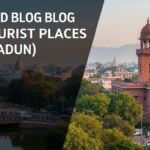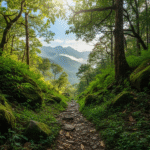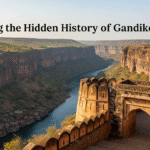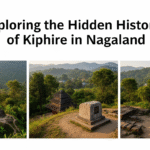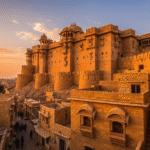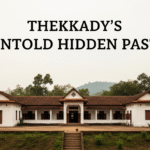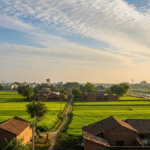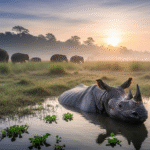The Manipur Dance Festival is special in India. It mixes spirituality and art beautifully. This festival showcases traditional Manipuri dance, unique forms, and mystical rituals. It’s set in India’s beautiful northeastern region. The festival tells stories of cosmic creation and divine play through dance. It shows the deep roots of Manipuri culture.
The Manipur Dance Festival is very attractive. It combines culture and new dance moves. People from everywhere come to see the dance stories of this festival. The dances share the deep culture of Manipur with everyone.
This festival has dances that tell ancient stories with spirit and ritual. People get lost in a mystical dance journey. The Manipur Dance Festival is more than fun. It shows the strength and growth of Manipuri dance over time.
If you want to experience a cultural event full of tradition, spirit, and togetherness, check out the Manipur Dance Festival. Every move tells a story of Northeastern India’s amazing festivals.
Key Takeaways
- The Manipur Dance Festival is a stunning showcase of traditional Manipuri dance and culture.
- Unique dance forms and mystical rituals are at the heart of the festival’s allure.
- Audiences are invited to witness the spiritual storytelling inherent in Manipuri performances.
- The festival is a testament to the rich tapestry of Northeastern Indian festivals.
- It is an opportunity to see the evolution of Manipuri dance expressed through time-honored traditions.
- Artistry and spirituality converge at the Manipur Dance Festival, offering a deeply immersive cultural experience.
Unveiling the Mystique of Manipur’s Dance Heritage
Northeast India is full of cultural sights. Among these, Manipur’s dance forms brightly shine. They show the region’s rich history and beauty. The dances aren’t just steps. They carry age-old stories and meanings from the past.
The heart of this heritage is the Manipuri dance. It’s more than a performance. It tells stories and expresses feelings, all while keeping true to Vedic traditions. These dances share tales of gods like Radha and Krishna. They’ve been celebrated since old times.
The Historical Genesis of the Festival
Manipur’s dance comes from a mix of myth and spirit. Its roots are in Vedic traditions, where dance was a divine act. Through the years, it became structured. It’s now part of festivals and religious events, carving its place in Manipur’s identity.
Manipuri Dance and its Connection to Vedic Traditions
Manipuri dance beautifully mixes spirituality with performance. It gracefully brings to life Hindu stories. The Ras Lila, a classical dance, shows the love and play between Radha and Krishna. It displays the depth of Vedic traditions.
Manipur’s dance heritage lights up in performances. Every step and note brings history to life. It celebrates the woven Vedic traditions in Manipur’s culture.
The Cultural Tapestry of Manipur Dance Festival
The Manipur Dance Festival is a vibrant celebration of life and color. It showcases the rich culture of Northeast India. Here, dances connect the past and present, and local with global. They enchant audiences worldwide.
Tribal Folk Dances: A Glimpse into Tribal Traditions
The tribal folk dances give a unique view of indigenous life. Their rhythmic moves echo the bond with nature. These dances share stories passed down for generations. They are performed with great pride.
Manipuri Classical Dance: An Artistic Marvel
Manipuri classical dance is a structured, yet profound art. It is known for its grace and spirituality. This dance is more than beauty; it reflects Manipur’s cultural depth and philosophy.
| Statistic | Detail |
|---|---|
| Annual Attendance | 2,000 |
| Local Manipuri Performers | Over 50% |
| Fusion Dance Performances | 20% |
| Traditional Dance Forms Showcased | 30+ |
| Ticket Sales Growth Over 3 Years | 15% |
| Social Media Engagement Growth | 25% |
| Budget Allocation for Traditional Dance Preservation | 70% |
| Media Coverage | 15 national and international outlets |
| Tourist Audience Percentage | Approx. 40% |
| Revenue Reinvested in Emerging Talents | 10% |
These statistics highlight the festival’s impact. They show its role in promoting Manipur’s dance heritage. It’s a key event for global cultural fans.
Experiencing the Spiritualism in Traditional Manipuri Dance
Northeast India’s festivals let you feel the region’s spiritual heart. The traditional Manipuri dance shines during the Ras Lila and Pung Cholom. These performances are deep expressions of spiritualism.
The festivals in Manipur share exciting dances. They also offer a glimpse into the deep thoughts that shaped them over the years.
Ras Lila: Spiritual Narratives through Movement
Ras Lila combines the spiritual and the artistic. It shows the love and dances of Radha and Krishna. It’s more than just a show; it’s a spiritual journey for all.
The costumes and gestures express devotional love and joy. They show deep spiritualism in traditional Manipuri dance.
Pung Cholom: The Symbiotic Union of Drumming and Dance
In Pung Cholom, rhythm and movement create powerful performances. Drummers leap and twirl to the beats. This shows unity and spiritual togetherness through the drums.
The festivals’ events highlight the essence of Manipuri culture. Every drum beat and dance step is a deep act of worship. It shows a meditation-like state that reflects true spiritualism.
Looking at these arts as spiritual shows us their importance in Manipur’s festivals. Through each movement and beat, the performers not just keep tradition alive. They infuse the spiritual values Manipur stands for.
Mysterious facts about the Manipur Dance Festival
The Manipur Dance Festival is more than a dance celebration. It holds deep, cultural secrets. These secrets show how dance and myths come together in an amazing way.
The ancient Kangla Fort in Imphal is crucial to the festival. It was once a cultural hotspot. This fort adds historical mystery to the dances at the event. It shows the festival’s rich past, making performances more meaningful.
Loktak Lake is another mysterious site near the festival. It’s the biggest freshwater lake in Northeast India. Its beauty and nature inspire many dances at the festival. This shows the deep link between the environment and dance.
The festival is also known for its spiritual dances. Such dances are seen as offerings to the gods. This mix of spirituality and art gives everyone a deep experience. It makes the festival even more special.
Then, there’s the Imphal War Cemetery and the Women’s Market, or Ima Keithel. The cemetery shares stories of bravery and global ties in World War II. The market highlights women’s strength and economic roles in Manipur. Both places add depth to the festival’s story.
Each part of the festival, from Imphal’s beauty to the historic Kangla Fort, keeps its mysterious aura. They all make the Manipur Dance Festival a celebration of dance and cultural mysteries.
Unique Dance Forms: The Hallmarks of the Festival
The Manipur Dance Festival is famous for its traditional and innovative dances. It showcases the area’s culture and modern dance moves. Thang Ta and Khamba Thoibi are key highlights. They show Manipur’s martial arts and romantic stories.
Exploring Thang Ta and Khamba Thoibi Dances
Thang Ta combines martial arts and dance. It shows the bravery of Manipuri culture. Khamba Thoibi dance is about love and myths. It’s known for its smooth moves and beauty. These dances add variety to the festival and keep Manipur’s culture alive worldwide.
Contemporary Choreography: Fusion with Tradition
Modern dance at the festival links old and new styles. It brings new life to traditional dances. This mix keeps the dances exciting and relevant today. It appeals to people everywhere.
The festival mixes old stories and new dance in an interesting way. This mix keeps classic Manipuri dances fresh while adding modern moves. It’s a must-see event for anyone who loves dance.
Mystical Rituals and Enigmatic Performances Unraveled
The Manipur Dance Festival is a heart of culture in Manipur. It shines with mystical rituals and mysterious acts from old traditions. Lai Haraoba and Maibi Jagoi are special. They are not just dances. They are spiritual rituals that connect the past and present beautifully.

Lai Haraoba: Celebrating Creation with Cosmic Energy
Lai Haraoba means “merrymaking of the Gods.” It celebrates the universe’s creation. This old ritual is key in the Manipur Dance Festival. It shows a close bond with cosmic energies through mysterious acts.
The festival combines dance, music, and stories. It shows the Meitei people’s view of the universe. This creates a strong link with nature and the spiritual world.
Maibi Jagoi: Invoking Divine Spirits through Dance
Maibi Jagoi is just as fascinating. In it, Maibis – priestess dancers – call on divine spirits. This ritual is a big part of the festival’s mystical acts. With gentle steps and calm faces, Maibis share the divine feeling. This wraps viewers in a blanket of spiritual awe.
The dance shares ancient folk stories through each move and pose. It is a key part of the festival’s spiritual feel.
To end, the Manipur Dance Festival is a bright spot for Lai Haraoba and Maibi Jagoi. It lets people see the deep parts of Manipuri culture. These mystical rituals and mysterious acts bring everyone closer.
Exploring the Cultural Significance of Northeastern Indian Festivals
The festivals of Northeastern India mean a lot to its people. They show the area’s history, diversity, and faith through colorful and lively events. Every fest, from Manipur’s hills to Assam’s peaceful lands, brings local traditions to life. They maintain Northeast India’s unique culture.
At these festivals, people come together. They celebrate their heritage and build a strong community. Festivals make sure that everyone feels connected. They remind people of their shared stories.
The Shirui Lily Festival in Manipur celebrates the region’s environment by honoring the state flower. The Ziro Music Festival in Arunachal Pradesh shows off great music and promotes cultural tourism. Both are important for the area.
In every rhythm, dance, and melody played during these festivals, there lies a profound narrative of ancient traditions and modern transitions alike, intertwining to form the cultural heritage of Northeast India.
| Festival | Location | Best Time to Visit | Significance |
|---|---|---|---|
| Dwijing Festival | Assam | December-January | A celebration under the Hangrama Bridge along the scenic Aie River, lasting 12 days. |
| Majuli Music Festival | Assam | November | An exuberant 3-day event celebrating the indigenous music and culture of Assam. |
| Kangchup Hill | Manipur | September-March | Recommended period for visiting to experience the sublime beauty and cultural festivities. |
| Shirui Lily Festival | Manipur | May | A 4-5 day festival celebrating the state flower with extensive cultural performances and exhibitions. |
These festivals help keep cultures alive and sustainable. They build strong, resilient communities. Arts, crafts, and traditions of Northeastern India are shared and loved. These celebrations are key to understanding and appreciating the area’s cultural wealth.
Inside the Enigmatic Performances: Costume and Narratives
The Manipur Dance Festival shines with its enigmatic performances. Every part, like Manipuri dance costumes and the dancers’ gestures and expressions, is key. These elements blend to share an exciting story. This mix adds to the dance, making it special.
The Intricacies of Manipuri Dance Costumes
Manipuri dance looks stunning thanks to detailed costumes. They show Manipur’s rich culture. These aren’t just clothes. They’re artworks fitting the dance themes. The colors and designs in the costumes help tell the story. Each color and pattern has a meaning that adds to the dance tale.
Storytelling through Gestures and Expressions
In Manipuri dance, stories come alive beyond the plot. Dancers use gestures and expressions for this. A slight look or a firm stance tells a lot. Dancers work hard to share emotions and story parts without words. This lets people understand the story without needing words.
The table below shows how Manipuri dance costumes help tell and beautify the story:
| Costume Component | Description | Symbolic Significance |
|---|---|---|
| Potphei | A richly woven skirt with traditional motifs | Represents the historical and cultural heritage of Manipur |
| Kumil | An ornate blouse worn by female dancers | Symbolizes femininity and grace |
| Pagri | A turban that complements the male dancer’s attire | Denotes respect and reverence in Manipuri culture |
| Leirum Phee | A scarf-like accessory that highlights movement | Used to emphasize the fluidity and emotion of dance movements |

The design of Manipuri dance costumes and the dancer’s gestures and expressions work together. They tell stories through enigmatic performances. Every move, from a hand twist to a skirt swirl, paints a picture. It makes Manipuri dance an unforgettable cultural event.
Conclusion
The Manipur Dance Festival is more than just an event. It is a vivid example of Manipuri culture. It shows the richness of their traditions through dance and stories. This festival links the past to the present in a beautiful way.
This event is a journey into Northeastern Indian celebrations. Each dance tells an ancient story, showing the spirit and art of Manipur. It shines a light on Manipuri customs for the world to see and appreciate. This helps keep the culture strong and known everywhere.
Cultural festivals like this one are key for keeping traditions alive, adapting over time. The Manipur Dance Festival merges old and new gracefully. It wins the hearts of many and shows the dynamic culture of Manipur. This festival is indeed a bridge between yesterday and tomorrow.
FAQ
What is the Manipur Dance Festival?
The Manipur Dance Festival is a yearly event. It honors the rich culture and traditional dances of Manipur, a northeastern Indian state. It features different performances based on ancient Vedic traditions and a collection of unique dance forms.
How does the Manipur Dance Festival reflect Manipuri culture?
This festival shows Manipuri culture through its traditional dances. Each dance is key to the state’s history and spiritual life. Folk dances show old community traditions. Classical dances show high-level skill. Together, they weave Manipur’s rich cultural fabric.
Why is the historical genesis of the Manipur Dance Festival significant?
The festival’s history is key because it connects to old Vedic traditions and local tales. These have been saved and shared for many generations. This link to ancient traditions shows the festival’s deep importance to the Manipuri people.
What are some examples of traditional Manipuri dance showcased at the festival?
Ras Lila and Pung Cholom are main dances at the festival. They show spiritual stories and the mix of drumming and dance. Other dances like Thang Ta and Khamba Thoibi also delight audiences. They tell stories and show skill.
Can you mention some mysterious facts about the Manipur Dance Festival?
The festival has mysterious performances and rituals. Lai Haraoba talks about the world’s creation. Maibi Jagoi is dances by priestesses to call on divine spirits. These parts add mystery and deep spiritual meaning to the festival.
How do contemporary choreography and traditional themes blend at the festival?
Modern dance styles mix with old themes at the Manipur Dance Festival. This mix creates a new expression. It appeals to young people while honoring traditional Manipuri dance forms.
What mystical rituals are performed during the festival?
Mystical rituals include Lai Haraoba, which honors cosmic creation, and Maibi Jagoi, a divine dance. These are key, fascinating parts of the festival. They show Manipur’s deep spirituality and ritual traditions.
What is the cultural significance of Northeastern Indian festivals like the Manipur Dance Festival?
Festivals in Northeastern India help bring different ethnic groups together. The Manipur Dance Festival shows off the area’s rich culture. It celebrates heritage and boosts pride among diverse local communities.
How do costumes and narratives contribute to the performances?
Manipuri dance costumes are colorful and detailed. They help tell the dance’s story. Dancers use gestures and facial expressions to share the narrative. This adds depth and emotion to the performances.

